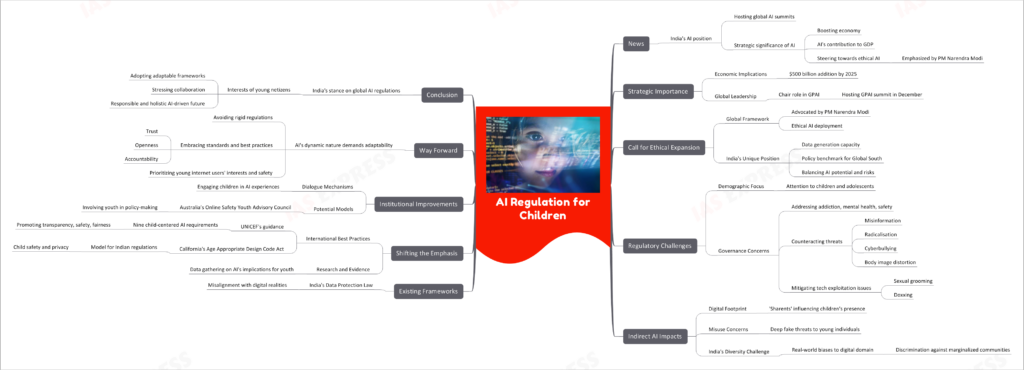AI Regulation- How can it cover the Children?
From Current Affairs Notes for UPSC » Editorials & In-depths » This topic
IAS EXPRESS Vs UPSC Prelims 2024: 85+ questions reflected
India, poised to host two major global AI summits in the upcoming months, reveals the strategic significance of AI, which is anticipated to substantially boost its economy. As AI potentially contributes to 10% of India’s targeted GDP, the nation is on the brink of a revolution, steering the conversation towards responsible and ethical expansion of AI, a priority emphasized by the Prime Minister.

Strategic Importance
- Economic Implications: AI is expected to add $500 billion to India’s economy by 2025.
- Global Leadership: As the Chair of the Global Partnership on Artificial Intelligence (GPAI), India is hosting the GPAI global summit in December.
Call for Ethical Expansion
- Global Framework: PM Narendra Modi advocates for an international structure focused on ethical AI deployment.
- India’s Unique Position:
- Enormous data generation capacity.
- Opportunity to set policies and become a benchmark for the Global South.
- Key focus on balancing AI’s potential with its associated risks.
Regulatory Challenges
- Demographic Focus: Critical attention needed for children and adolescents who access AI-driven services.
- Governance Concerns:
- Address addiction, mental health, and safety concerns.
- Counteract potential threats like misinformation, radicalisation, cyberbullying, and body image distortion.
- Mitigate issues emerging from tech exploitation, like sexual grooming and doxxing.
Indirect AI Impacts
- Digital Footprint: Parents’ (‘sharents’) digital activities influence their children’s online presence.
- Misuse Concerns: AI-powered deep fake capabilities may endanger young individuals.
- India’s Diversity Challenge: Transposing real-world biases from various intersectional identities into the digital domain can lead to discrimination against marginalized communities.
Existing Frameworks
- India’s Data Protection Law: Current provisions misaligned with digital realities and might inadvertently put children at risk.
Shifting the Emphasis
- International Best Practices:
- UNICEF’s guidance: Emphasizes nine child-centered AI requirements, fostering an environment that promotes transparency, safety, and fairness.
- California’s Age Appropriate Design Code Act: A potential model for Indian regulations to ensure child safety and privacy in the digital realm.
- Research and Evidence: Authorities must gather data to understand the implications of AI on the younger demographic.
Institutional Improvements
- Dialogue Mechanisms: Engage children in discussions about their experiences with AI services.
- Potential Models: Consider institutions like Australia’s Online Safety Youth Advisory Council to involve youth in policy-making.
Way Forward
The dynamic nature of AI demands a flexible and evolving approach. To harness its benefits while mitigating risks:
- Avoid rigid regulatory prescriptions.
- Embrace standards and best practices emphasizing trust, openness, and accountability.
- Prioritize the interests and safety of young internet users.
Conclusion
As India gears up to leave its mark on global AI regulations, it’s paramount that the interests of its young netizens are kept at the forefront. Embracing adaptable frameworks and emphasizing collaboration can ensure a holistic and responsible AI-driven future for the nation.
Practice Question for Mains
Discuss how AI regulation could address the needs of the young netizens. What are the challenges and way ahead? (250 words)
If you like this post, please share your feedback in the comments section below so that we will upload more posts like this.

